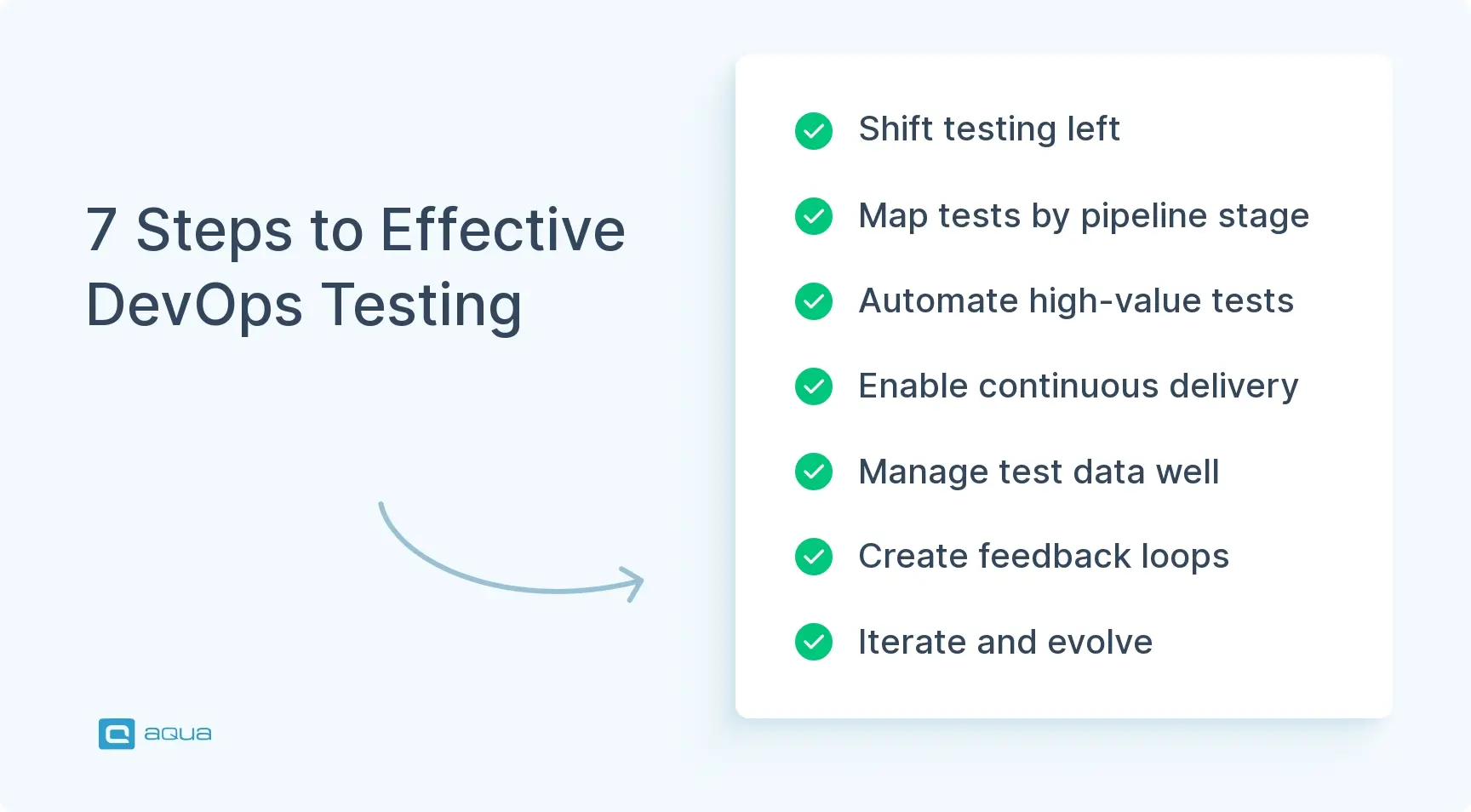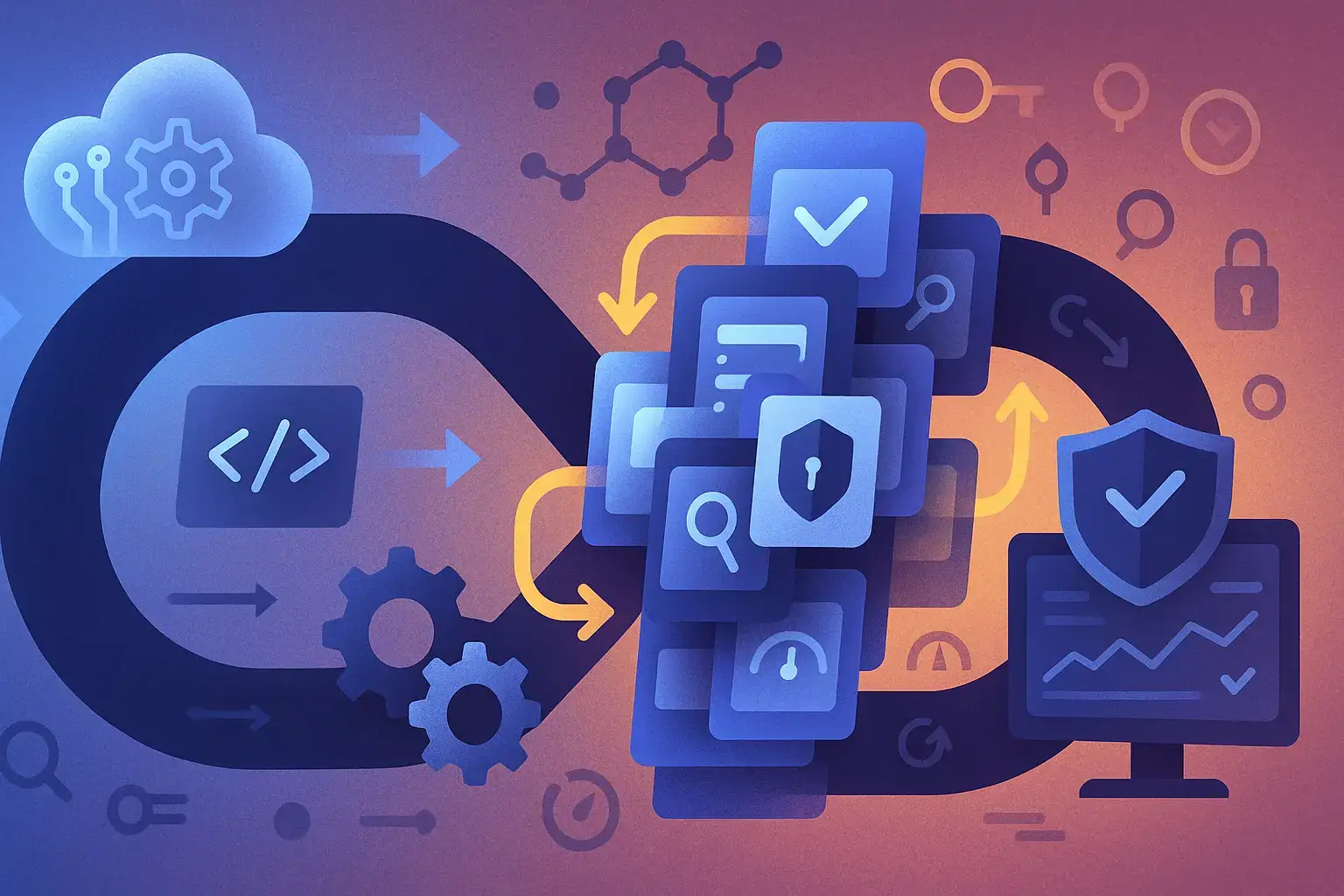Key Takeaways
- DevOps testing integrates quality checks throughout the development process instead of creating bottlenecks at the end, enabling faster and more confident deployments.
- Continuous testing runs automatically at different levels (unit, integration, system, performance, security) to catch issues when they’re fresh and cheaper to fix.
- Effective DevOps testing strategies start by shifting left, mapping test coverage across the pipeline, and building automation strategically for high-value tests.
- Environment consistency is crucial for reliable testing, requiring containerization, infrastructure as code, and maintaining configuration parity between testing and production.
- AI is transforming DevOps testing with automatic test generation, self-healing automation, intelligent test selection, and predictive failure analysis.
Traditional testing creates expensive bottlenecks when bugs are discovered late, while DevOps weaves quality into every step of development. Ready to transform your release speed while actually improving quality? Discover the complete strategy below 👇
How DevOps Changes the Testing Game
Traditional testing creates a bottleneck. Developers finish their work, then testing begins, and then bugs get discovered when they’re expensive to fix. DevOps eliminates this waiting game.
Instead of testing at the end, DevOps weaves quality checks throughout your development process. Tests run automatically when developers commit code. Staging environments verify everything works before production. Issues get caught and fixed within hours, not weeks.
This happens because DevOps breaks down team silos. Your key changes include:
- Shared ownership: Everyone takes responsibility for quality, not just QA
- Continuous testing: Tests run constantly in the background, not in big batches
- Faster feedback: Problems surface immediately when they’re easier to fix
- Automated workflows: Machines handle repetitive checks while humans focus on complex scenarios
As a result, your team stops playing defence against production bugs and starts preventing them. Testing transforms from a checkpoint that slows releases into a safety net that enables faster, more confident deployments.
Why Continuous Testing Matters in DevOps
Continuous testing is what makes DevOps actually work. Instead of testing only at specific milestones, your tests run automatically throughout development—catching issues as they happen rather than discovering them weeks later.
This shift delivers real value for your team. You catch defects when they’re still fresh in developers’ minds and cheaper to fix. Your feedback loops get faster, so code problems don’t compound. Most importantly, you build confidence in your releases because you know your code has been tested at every step.
Testing at Different Levels: DevOps testing is a layered approach that catches different types of issues:
| Test Type | When It Runs | Purpose | Typical Tools |
|---|---|---|---|
| Unit Tests | Every commit | Verify individual components work as expected | JUnit, NUnit, Jest |
| Integration Tests | Several times daily | Confirm components work together properly | Selenium, Postman |
| System Tests | Daily / nightly | Validate complete system functionality | Cucumber, TestNG |
| Performance Tests | Weekly / per sprint | Ensure system meets speed requirements | JMeter, LoadRunner |
| Security Tests | Weekly / per sprint | Identify vulnerabilities | OWASP ZAP, Nessus |
Automated Triggers Make It Seamless: The power comes from automation. When a developer pushes code, unit and integration tests run automatically. When code gets merged to your main branch, a full test suite kicks off. Your team doesn’t have to remember to run tests. The pipeline handles it.
This means your team always knows the health of your codebase. No more surprises in production, no more “it worked on my machine” conversations. Everyone works with the same tested, validated code.
How to Build an Effective DevOps Testing Strategy
Creating a DevOps testing strategy that actually works requires adapting proven principles to your team’s specific context. You’re not starting from scratch. Successful organisations follow similar patterns that you can customise for your situation.
Start by Shifting Left with Your Testing: The biggest change from traditional approaches is involving testers from day one. Your testers need to be in planning meetings, helping define acceptance criteria before coding starts, and collaborating on what “done” means for each feature. This early involvement prevents the costly rework that happens when testing requirements emerge late in development.
Map Your Testing Throughout the Pipeline: Take inventory of what testing you need at each stage. Unit tests run with every commit, integration tests verify components work together, and system tests validate complete functionality. The key is creating a visual map of your testing flow so you can see gaps in coverage and understand who owns what types of testing.
Build Automation Strategically: Automation enables DevOps speed, but trying to automate everything at once leads to frustration. Start with your highest-value, most repetitive tests, the ones that provide quick feedback and catch common issues. Focus on building a reliable foundation before expanding to complex scenarios.
Your continuous integration pipeline should automatically build and test code with each commit. This provides immediate feedback and prevents broken code from advancing. The safety net lets developers move confidently without fear of breaking things.
Extend to Continuous Delivery: Once your CI foundation is solid, extend your pipeline to deploy automatically to testing environments. Integration and system tests run in these environments to prepare release candidates that are genuinely ready for production. This enables one-click deployments when tests pass.
Handle Test Data Properly: Your tests are only as reliable as your test data. Create mechanisms for generating consistent test data, consider privacy regulations in testing environments, and automate test data setup and teardown. This prevents tests from interfering with each other.
Create Feedback Loops: Track test coverage, execution times, and failure patterns. Use this data to continuously refine your approach. Successful DevOps testing strategies evolve based on real results rather than assumptions.

Remember that this is an iterative process. Start with the basics and expand as your team develops DevOps maturity.As you’re developing your DevOps testing strategy, the right test management platform can be the difference between a streamlined pipeline and a bottleneck of manual processes. aqua cloud seamlessly integrates into your DevOps toolchain with out-of-the-box connections to essential tools like Jira, Jenkins, and Azure DevOps. With aqua’s AI-powered test generation capabilities, your team can create test cases in seconds rather than hours, shifting testing left without sacrificing thoroughness or quality. Unlike isolated testing solutions, aqua provides a centralised hub where both manual and automated tests coexist, creating comprehensive traceability from requirements to test execution. The platform’s REST API ensures you can connect any additional tools in your CI/CD pipeline, maintaining the flexibility DevOps demands. Why build your DevOps testing strategy on fragmented tools when you can unify your approach with a platform designed for continuous testing?
Reduce test creation time by up to 97% while ensuring complete pipeline integration
Tools for Enhancing DevOps Testing
The right tools can accelerate your DevOps testing strategy, while the wrong ones create bottlenecks and frustration. Rather than chasing the latest trends, focus on tools that integrate well with your existing workflow and solve your specific problems. There are different types of tools for different purposes.” Let’s consider and explore these different categories and identify the best tools within each.
Continuous Integration Tools: Your CI system is where automated testing begins. Every code commit should trigger builds and tests automatically, giving developers immediate feedback about their changes. The tool you choose becomes the backbone of your entire testing pipeline, so reliability and ease of use matter more than flashy features.
| Tool | Key Features | Best For | Limitations |
|---|---|---|---|
| Jenkins | Highly customizable, extensive plugin ecosystem | Teams needing flexibility and custom workflows | Requires more configuration and maintenance |
| GitLab CI | Tight integration with GitLab, built-in CI/CD | Teams already using GitLab for source control | Not as feature-rich for non-GitLab users |
| CircleCI | Easy setup, great Docker support | Teams wanting quick implementation with minimal overhead | Can get expensive with multiple concurrent jobs |
| GitHub Actions | Native GitHub integration, marketplace workflows | GitHub users with straightforward CI needs | Less mature than other options |
| TeamCity | Excellent .NET integration, intuitive UI | Enterprise .NET teams | Licensing costs for larger teams |
Test Automation Tools: Manual testing can’t keep up with DevOps speed, so automation handles the repetitive verification work. Different tools excel at different types of testing—web applications, APIs, mobile apps, or cross-browser compatibility. Choose based on what you’re actually building, not what’s popular.
| Tool | Key Features | Best For | Limitations |
|---|---|---|---|
| Selenium | Cross-browser testing, multiple language support | Web application testing across browsers | Requires programming knowledge, setup time |
| Cypress | Fast execution, real-time reloading | Modern web app testing with JavaScript | Limited to Chrome-family browsers |
| Playwright | Multi-browser, multi-language API | Cross-browser testing with fewer flaky tests | Newer tool with developing ecosystem |
| Postman | API testing and documentation | Teams focused on API quality | Limited for UI testing |
| Appium | Mobile native and hybrid app testing | Teams building mobile applications | Complex setup, device management |
Performance and Monitoring: Keeping Production HealthyTesting doesn’t stop at deployment. You need visibility into how your application performs under real load and in production environments. These tools help you catch performance issues before users do and provide the data needed to optimize your system.
| Tool | Key Features | Best For | Limitations |
|---|---|---|---|
| New Relic | Real-time performance monitoring | Production monitoring and troubleshooting | Costly at scale |
| Grafana | Customizable dashboards, multiple data sources | Teams wanting visualization flexibility | Requires setup and configuration |
| JMeter | Open-source load testing | Teams on a budget needing load testing | Steeper learning curve, basic UI |
| Datadog | Unified monitoring across platforms | Large organizations with diverse technology stacks | Premium pricing |
| Splunk | Powerful log analysis and correlation | Enterprise environments with complex systems | Expensive licensing, complex setup |
Making Smart Tool Choices: When selecting tools, consider integration capabilities with your existing stack, learning curve for your team, scalability as your testing needs grow, and total cost, including maintenance and training. Success in DevOps teams doesn’t just rely on tools. You should carefully select ones that work well together, creating a streamlined testing ecosystem where information flows smoothly across the pipeline.
Best Practices for Implementing DevOps Testing
Successful DevOps testing is all about adopting practices that make quality a natural part of your development flow. These approaches have proven effective across different types of organisations and team sizes.
Shift Left: Catch Issues Early: The earlier you find problems, the cheaper and easier they are to fix. Moving testing earlier in your development cycle means writing tests before code, having developers run tests locally before commits, and making test failures immediately visible to everyone. When your entire team sees test results in real-time, quality becomes a shared responsibility rather than an individual burden.
- Write tests before code (Test-Driven Development)
- Have developers run tests locally before commits
- Automate tests that run on every commit
- Make test failures visible to the entire team immediately
Mirror Production in Your Test Environments: Tests are only valuable if they reflect real-world conditions. Use infrastructure as code to ensure consistency between environments, implement containerization for reproducible setups, and maintain configuration parity between testing and production. Consider how your production data characteristics affect testing scenarios.
- Use infrastructure as code to ensure consistency
- Implement containerization for reproducible environments
- Maintain parity in configurations between testing and production
- Consider data characteristics when designing test environments
Build Quality Into Your Culture: Quality can’t be an afterthought or one person’s job. Make it everyone’s responsibility by celebrating bug prevention alongside bug fixing. Include quality metrics in team performance evaluations and rotate developers through testing roles so everyone understands the testing perspective.
- Make quality everyone’s responsibility, not just QA’s
- Celebrate bug prevention rather than just bug fixing
- Include quality metrics in team performance evaluations
- Rotate developers through testing roles periodically
Maintain Your Test Suite Health: Test suites degrade over time without active maintenance. Regularly review and refactor tests, monitor execution times and optimise slow ones, and address flaky tests immediately before they erode team confidence. Balance comprehensive coverage with realistic maintenance costs.
Apply Smart Testing Strategies: Not all tests are equally important. Use risk-based testing to prioritise critical user paths, follow test pyramid principles with more unit tests than UI tests, and implement parallel testing for faster feedback. Generate test data automatically to cover edge cases that manual test data creation might miss.
Treat Test Code as Production Code: Your test code deserves the same care as your application code. Apply identical code review standards, version control all test assets, refactor when needed, and document your testing approaches and patterns so knowledge stays with the team.
Communicate Testing Status Clearly: Create dashboards showing test status and trends, communicate failures clearly and quickly, document testing coverage gaps, and share testing knowledge across teams. Transparency builds confidence and helps everyone make informed decisions about releases.
Start small with one or two practices that address your biggest pain points. Perfect them before adding others, as sustainable improvement beats overwhelming change every time.
Implementing an effective DevOps testing strategy requires tools that embrace both speed and quality. aqua cloud stands out as a comprehensive test management platform built specifically for modern DevOps environments. Its bidirectional integrations with tools like Jira and Azure DevOps ensure your testing processes remain in sync with development, while its powerful API enables seamless incorporation into any CI/CD pipeline. The platform’s AI Copilot can transform your testing approach by automatically generating test cases using advanced techniques like Boundary Value Analysis and Equivalence Partitioning, saving up to 80% of manual effort. With aqua, you can balance shift-left testing through automation while maintaining robust traceability between requirements, tests, and defects. The platform’s real-time dashboards provide instant visibility into test coverage and quality metrics, enabling the continuous feedback essential to DevOps success. As you evolve your testing strategy, aqua grows with you, supporting everything from initial test creation to production monitoring and beyond.
Transform your DevOps pipeline with 100% test coverage and 80% less manual effort
Overcoming Challenges in DevOps Testing
A perfect DevOps testing strategy is a myth. Even well-planned ones hit obstacles. The key is recognising common challenges early and having practical solutions ready to implement.
When Tools Don’t Work Together: Integration problems can break your entire pipeline. Different tools use different data formats, APIs don’t communicate properly, and information gets lost between systems. This creates gaps where issues slip through or workflows get stuck.
Create a tools committee to evaluate integration capabilities before adopting new solutions. Use APIs and webhooks to connect systems that weren’t designed to work together. Companies like Spotify succeed by standardising on core tools with proven integration points rather than chasing every new solution that appears.
Environment Inconsistencies Create False Confidence: The “it works in development but fails in QA” problem undermines trust in your testing. When environments differ in configuration, dependencies, or data, your tests can’t reliably predict production behaviour.
Embrace containerization with Docker and orchestration tools like Kubernetes to ensure consistency across environments. Etsy solved this by implementing infrastructure as code: their testing environments automatically generate from the same templates as production, eliminating environment-related discrepancies.
Skills Gaps Slow Implementation: Teams often lack expertise in automation tools or testing practices. This creates bottlenecks where only a few people can write or maintain tests, limiting your testing capabilities and creating knowledge silos.
Implement paired programming between QA and development team members. Create internal training programs focusing on your specific technology stack. Netflix addressed this with “testing dojos”, time-boxed sessions where team members practice and learn testing techniques together.
Test Data Problems Block Comprehensive Testing: Generating realistic test data that covers edge cases without exposing sensitive information challenges most teams. Poor test data leads to gaps in coverage or privacy violations.
Build data generation services that create synthetic data matching production patterns. Capital One created a specialised service that generates realistic financial data for testing without exposing actual customer information.
Slow Tests Kill Developer Momentum: When tests take hours to complete, developers lose the fast feedback that makes DevOps effective. Long-running tests get skipped or ignored, defeating the purpose of automated testing.
Implement test parallelisation to run multiple tests simultaneously. Use smart test selection to run only tests relevant to recent changes. Create separate pipelines for fast smoke tests and comprehensive suites. Amazon categorises tests as “smoke” (minutes), “basic” (under an hour), and “complete” (several hours), running them at different pipeline stages.
Balancing Speed with Thoroughness: Teams struggle with the tradeoff between comprehensive testing and fast releases. Too much testing slows deployment, but too little testing increases production risk.
Adopt risk-based testing that applies intensive testing to high-risk areas while using lighter testing for stable, low-risk components. Google implements this with test sizing: categorising tests as small, medium, and large with different requirements for each category based on the component’s risk profile.
Future Trends in DevOps Testing
DevOps testing keeps changing as new technologies emerge and development practices evolve. These trends will shape how you approach testing in the coming years.
AI Makes Testing Smarter: AI tools can analyse your application and automatically generate test scenarios (like aqua cloud does, in a few seconds). Self-healing automation adjusts when UI elements change, reducing your maintenance work. Machine learning picks the most important tests to run based on your recent code changes. Some tools can even predict where failures might happen before they occur.
Testing Moves Into Production: Testing doesn’t stop at deployment anymore. Feature flags let you test changes with real users in controlled ways. Canary deployments test updates with small user groups first. Chaos engineering deliberately breaks things to see how your system responds. Production monitoring becomes part of your testing strategy instead of a separate activity.
Smarter Test Selection Saves Time: New tools figure out exactly which tests need to run when code changes. Instead of running everything every time, you run only the tests that matter for recent changes. Systems can prioritize tests based on which ones typically find problems. This approach gives you better testing efficiency without missing important coverage.
Security Testing Becomes Standard: Security checks are moving into regular testing workflows. Vulnerability scans run automatically alongside your functional tests. Tools check for risky dependencies in your code. Compliance verification happens as part of regular builds instead of separate audits. Security testing starts earlier in development rather than at the end.
Testing Tools Get Easier to Use: More people can create tests now without deep technical skills. Visual builders let non-programmers create automated tests. AI helps turn user stories written in plain English into actual test scripts. Business analysts and product managers can participate directly in quality assurance work.
Contract Testing Supports Microservices: As teams build more microservices, contract testing grows in importance. These tests check that services work together properly without testing entire systems. Teams can develop and test services independently while ensuring they still connect correctly.
Better Observability Replaces Basic Monitoring: Modern testing goes beyond simple uptime checks. Teams combine detailed tracing, metrics, and logs to understand exactly how systems behave. Testing and monitoring work together as one continuous process. Performance testing becomes as important as functional testing. User experience data drives what gets tested.
Teams that adapt to these changes will build better software with less effort. Future DevOps testing focuses on quality throughout the entire software lifecycle, not just before release.
Conclusion
Building an effective DevOps testing strategy means creating a culture where quality enables speed instead of fighting it. When you treat testing as part of development rather than a separate checkpoint, you can automate repetitive work, get fast feedback on changes, and continuously improve based on real results. It helps you ship software that actually works reliably for users. Start with your biggest pain points, implement changes gradually, and focus on building sustainable practices rather than trying to transform everything overnight. The effort you put into solid testing foundations will reduce production fires, enable confident releases, and ultimately create better experiences for the people who use your software.


















